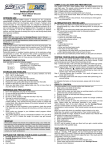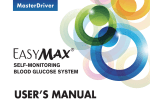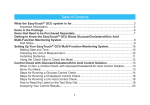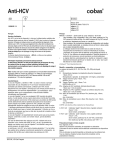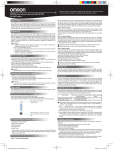Download User`s Manual - EPS Bio Technology Corp.
Transcript
MDT2 Self-Monitoring Blood Glucose System User’s Manual Please read this User’s Manual thoroughly before using your blood glucose meter. Dear MDT2 SMBG System Owner, Thank you for using the MDT2 Self-Monitoring Blood Glucose (SMBG) System. We designed this system to be dependable, easy-to-use, compact, lightweight and portable to help you monitor your blood glucose on a regular basis. Please read this manual thoroughly before you begin testing. This manual provides you and your diabetes care team with important information and step-by-step direction to use the MDT2 Self-Monitoring Blood Glucose System. To start testing quickly, you can also refer to the Quick Reference Guide. Thanks again for choosing the MDT2 SMBG System. Intended Use The MDT2 Self Monitoring Blood Glucose Test System is intended for the quantitative measurement of glucose in venous whole blood or fresh capillary whole blood from fingertips, palm and forearm. Testing is done outside the body (In Vitro diagnostic use). It is indicated for self-testing (over the counter [OTC]) by persons with diabetes, or in clinical settings by healthcare professionals, as an aid to monitor the effectiveness of diabetes control. Standard Accessories Your new MDT2 Blood Glucose meter and accessories work together to measure the amount of glucose in your blood. The system includes: • Blood Glucose Meter • Test Strip x 10 ct. • CR2032 Lithium Battery x 2 ct. • Lancet x 10 ct. • Lancing device • AST Lancing Device Cap • User’s Manual • Quick Reference Guide • Test Strip Instructions • Self-Test Log Book • Normal Control Solution • Control Solution Instructions • Carrying Case Optional Accessories • Low Control Solution • High Control Solution 1. Normal control solution is included with the system. 2. Low and High control solutions are available. For purchase, please contact your healthcare provider. Why is it so important to test blood glucose regularly? Testing your blood glucose regularly can make a big difference in how you manage your diabetes every day. We’ve made this SMBG system as simple as possible to help you to use the meter regularly. Your meter is easy to use, and you can adjust the lancing device for your comfort. Do you need Help? If you have questions or need assistance, please contact your healthcare provider. Although the MDT2 SMBG System is easy to use, you may need to consult with your healthcare professional (this may be your doctor, pharmacist or diabetes nurse educator) for instructions on how to use the system. Only the correct use of the system will ensure accurate results. Important Information about Your New Meter MDT2 blood glucose meter is designed and approved for testing fresh capillary blood from fingertip, palm and forearm. The meter is for in vitro diagnostic use ONLY (for testing outside the body). It should not be used to diagnose or screen for diabetes. MDT2 blood glucose meter can only be used with MDT2 Blood Glucose Test Strips. Other test strips will give inaccurate results. Testing is not valid for neonatal blood specimens. Do not disassemble the meter as this may cause damage to the components resulting in incorrect reading. Disassembling the meter will also void the warranty. Always keep the meter clean and store it in a safe place. Protect the meter from direct sunlight to ensure a longer lifespan. You should not store the meter and test strips in a car, a bathroom or a refrigerator. Keep the meter, test strips and lancing device away from children and pets. You should not test critically ill patients with home-use blood glucose meters. Incorrect results may occur when performing the test. If you believe you are not feeling well, please contact your healthcare professional. Remove batteries if the meter will not be used for one month or more. Please dispose device according to the local rule of the disposition of electronic device / accessory waste. Warning for potential biohazard: Healthcare professionals using this system on multiple patients should be aware that all products or objects that come in contact with human blood, even after cleaning, should be handled as if capable of transmitting a viral disease. Consult with your healthcare professional before testing on your palm or forearm. Do not touch the strips with wet hands. Do not use expired strips (the expiration date is shown on the bottle.) Do not bend, cut or twist the strips. Altitude up to 3,048 meters above sea level has no effect on readings. Health-Related Information If you are experiencing dehydration, frequent urination, low blood pressure, shock or hyperosmolar hyperglycemic nonketotic coma (HHNKC), you may get a test result that is lower than what your blood glucose really is. If you think you are dehydrated, call your doctor right away. If you have followed the steps in the user’s manual, but still have symptoms that do not seem to match your test results, or if you have questions, please contact your healthcare provider. Please read your test strip instructions carefully for additional health-related information. Warning for potential biohazard Healthcare professionals using this system on multiple patients should handle all products or objects in contact with human blood carefully to avoid transmitting viral disease, even after cleaning. Explanation of Symbols Consult instructions for use Caution Batch code Do not reuse In vitro diagnostic medical device 3V (CR2032) x 2 battery only Use by Temperature limitation Manufacturer Catalogue number Serial number Control Sufficient for Authorised representative in the European Community Blood glucose test result in mg/dL Blood glucose test result in mmol/L Green Dot / Duales System Deutschland GmbH (DSD) This product meets the requirements of Directive 98/79/EC in vitro diagnostic medical devices Explanation of Symbols (continued) Discard 6 months (180 days) after opening Large LCD screen Hypo alarm Keep away form sunlight 5-seconds result 0.6 μ L blood volume Alternative site testing Human-factor flow Explanation of Meter Symbols Date (on the left side) AM (Before Noon) Time (on the right side) PM (After Noon ) Control Solution AC (Before Meal) Alarm PC (After Meal) Record Error Insert strip Temperature Application of blood Unit USB connect Battery Table of Contents Chapter 1: Understanding Your Meter ….......................................................................................................13 The MDT2 Blood Glucose Meter …............................................................................................................13 The MDT2 Blood Glucose Test Strip and Accessories ……………............................................................14 Inserting Batteries …..................................................................................................................................15 Setting The Time And Date ........................................................................................................................16 Using MDT2 Blood Glucose Test Strips ....................................................................................................17 Chapter 2: Control Solution Test ...................................................................................................................18 Why Run a Control Solution Test ...............................................................................................................18 About The Control Solutions ......................................................................................................................19 Running A Control Solution Test ................................................................................................................20 Understanding Control Solution Test Results …........................................................................................22 Chapter 3: Testing Your Blood Glucose .......................................................................................................24 Using The Lancing Device .........................................................................................................................24 Inserting A Lancet into the Lancing Device ................................................................................................25 Running A Blood Glucose Test With Blood From Your Fingertip ..............................................................27 Alternate Site Testing (AST)……………………………………….…………………..………………...………..29 Running A Blood Glucose Test With Blood From Your Forearm ..............................................................31 Running A Blood Glucose Test With Blood From Your Palm ....................................................................32 Discarding Used Lancets ….......................................................................................................................33 Understanding Your Test Results …..........................................................................................................34 Unusual Test Results …………………………….......................................…………………………………...34 Symptoms of High or Low Blood Glucose..................................................................................................35 Comparing Your Meter Result To A Lab Result ….....................................................................................36 Chapter 4: Meter Memory, Setup …...............................................................................................................37 Memory, Storing Test Result …..................................................................................................................37 Viewing & Deleting Test Results …............................................................................................................38 Running With Your Computer….................................................................................................................39 Chapter 5: Maintenance And Troubleshooting ….........................................................................................40 Inserting Batteries …..................................................................................................................................40 Cleaning Your Meter and Lancing Device……...........................................................................................41 Maintenance And Testing ..........................................................................................................................42 Screen Messages And Troubleshooting …................................................................................................43 Chapter 6: Technical Information …..............................................................................................................49 Specifications ….........................................................................................................................................49 Limitation ….........................................................................................................................................50 Device Information ….................................................................................................................................52 Warranty ....................................................................................................................................................52 Chapter 1: Understanding Your Meter The MDT2 Blood Glucose Meter DisplayShows results, messages, and results stored in memory. ) ButtonLeft ( Press to enter memory, adjust setting, and scroll through results. Battery DoorFlip open the battery door by pushing the tab in the direction of the arrow. Right (OK) ButtonPress to enter memories, adjust setting, and scroll through results. Test Strip SlotInsert test strip here. 13 The MDT2 Blood Glucose Test Strip and Accessories Blood Glucose Test Strip Test Strip Bottle Control Solution Bottle Lancing Device A B Sleeve Hub C Trigger button D AST Lancing Device Cap Carrier E A. B. C. D. E. Blood collection area Reaction area Hand hold area Strip insert direction Electrode Expiration Date Adjustable tip 14 Inserting Batteries 1. Open the battery door on the back of the meter by pushing the tab in the direction of the arrow. 2. Insert two batteries. The meter will beep to confirm the batteries are inserted correctly. 3. Put the battery door back in place and snap it closed. 15 Setting The Time and Date—First Time Use Setting the current time and date in your meter is important if you intend to use the meter memory. 1. After inserting batteries, the meter turns on automatically. 2. The last 2-digits of the year flash at the center of the display. to adjust the year and Press Press OK to confirm the setting. 3. Repeat step 2 to set the date and time. The flashing field is the one you are currently setting. 4. The icon of flashes on the display. The meter is ready to run the test. The unit of blood glucose meter is set at mg/dL or mmol/L. If the display shows the wrong unit, please contact your local dealer for repair. 16 Using MDT2 Blood Glucose Test Strip Use only with MDT2 Blood Glucose Meter. Run a control solution test every time you open a new box of test strips (See Chapter 2 "Control Solution Testing.") Keep the test strips in their original bottle. After you take a test strip out of the bottle, tightly close the bottle immediately. This keeps the test strips dry. Use the test strip within three minutes after you take it out of the bottle. The strip is for single use only. Do not reuse it. Record the date you open the test strip bottle. Be sure to check the “Expiration date” on the test strip bottle. The test strip is good for six months from the date the bottle is opened or until the expiration date on the bottle, whichever comes first. Store the test strip bottle and your meter in a cool dry place. Store the test strips between 2°C ~30°C (36°F - 86°F). Do not freeze. Do not apply blood or control solution to the test strip before you insert it into the meter. Do not touch the test strip with wet hands. Do not bend, cut, or twist the test strips. 17 Chapter 2: Control Solution Testing Why Run A Control Solution Test We recommend that you run the MDT2 control test because it lets you know that your meter and test strips are working properly to give you reliable results. You should run the control solution test when: You use the MDT2 Blood Glucose Meter for the first time. You open a new bottle of test strips. You think the meter or test strips may be working incorrectly. You drop the meter. You have repeated a test and the test results are still lower or higher than expected. You are practicing the test procedure. Professional users are instructed to follow federal, state, and local guidelines. 18 About The Control Solution Use only with MDT2 test strips. Write the date you opened the bottle on the bottle label. The control solution is good for three months from the date the bottle is opened or until the expiration date on the bottle, whichever comes first. Do not use a control solution that is past the expiration date. The control solution can stain clothing. If you spill it, wash your clothes with soap and water. Close the bottle tightly after every use. Left over control solution should not be added back into the control bottle. Store the bottle of control solution at room temperature, between 2°C~30°C (36°F - 86°F). Do not freeze. If you would like to purchase MDT2 Control Solutions, please contact your healthcare provider. 19 Running A Control Solution Test You need the meter, a test strip, and control solution. 1. Put a test strip into the meter in the direction of the arrow and the icon of shows itself. to set the mode of 2. Press control solution “ ”. Press OK to confirm the setting. 3. Place the meter on a flat surface, like a table. 4. Remove the control solution bottle cap and wipe the tip of the bottle with a tissue. If you do not choose “CtL”, the test results will be included in the memory of blood test. 20 5. Squeeze the bottle until a tiny drop forms at the tip of the control solution cap. 6. Touch the drop to the Blood collection area at the end of the test strip. 7. Do not put control solution on top of the test strip. 8. When the icon of shows, the meter beeps, you have enough control solution for the test. 9. The meter starts to count down from 5 seconds and will show the results. A result appears on the display. 10. Don’t remove the test strip yet. Check if the reading falls within the range printed on the test strip bottle. 11. Remove the test strip and throw it away after you have compared the reading to the range printed on the test strip bottle. 21 Understanding Control Solution Test Results The label on your test strip bottle shows the acceptable ranges for the Control Solutions. The result you get should be inside this range. Make sure you compare the result to the correct level of control. When the control solution result is inside the range on the test strip bottle, your test strips and your meter are working properly. If your control solution result is not inside the acceptable range (printed on your test strip bottle), here are some things you can do to solve the problem: Control Solution values will be included in the memory and averages. Refer to the section “Viewing & Deleting Test Results” to delete the control solution values before averaging your test results. 22 Troubleshooting Checks Action 9 Was the test strip exposed to open air for a long period of time? If yes, repeat the control test with properly stored strips. 9 Was the test strip bottle capped tightly? If no, this will humidify strips inside. Replace the test strips. 9 Was the meter functioning well? You can use the control solutions to verify the meter’s functions. 9 Is the control solution expired or contaminated? If yes, replace with a new control solution to check the performance of SMBG system. 9 Were test strips and control solutions stored in cool, dry places? If no, repeat the control test with properly stored strips or control solutions. 9 Did you follow the testing steps properly? Read Chapter 2 "Control Solution Testing" and test again. Stop using the meter if you continue to obtain the inaccurate results. 23 Chapter 3: Testing Your Blood Glucose Using The Lancing Device The best depth setting is the lowest number that draws enough blood for a test. Try different settings to find the one that’s right for you. Please do not share your lancing device with anyone. And always use a new, sterile lancet. Lancets are for one time use only. Used test strips and lancets are considered bio-hazardous waste in accordance with local regulations and should be handled as if capable of transmitting infection. The users may discuss methods for disposing of used test strips and lancets with their doctor. 24 Inserting A Lancet Into The Lancing Device You must first load the lancet into the lancing device to get it ready for use. 1. Unscrew the Cap. 2. Insert the lancet into the lancing device firmly then twist off the protective cover. 3. Recap the front cap. Lancets are for use only and a new, sterile lancet should be used each time you perform a test. 25 4. Select the desired penetration depth. 5. Pull on the sliding barrel of the lancing device until it clicks and then release. Now the lancing device is ready. Do not prick your finger until your meter and strip are prepared. 6. Set the lancing device aside until later in the test. 1. Select 1-2 for soft or thin skin, 3-4 for average, and 5-6 for thick or calloused skin. 2. Lancing device and lancets are not to be shared between users. Sharing lancing devices and lancets may transmit blood borne pathogens, such as viral hepatitis. 26 Running A Blood Glucose Test With Blood From Your Fingertip 1. Wash your hands with soap and warm water. Rinse and dry thoroughly. 2. Insert a test strip into the meter in the direction of the arrow and the icon flashes. 3. Press to set , or and press OK to confirm the setting. 4. When the blood drop flashes on the display, obtain a drop of blood from your fingertip. 5. Gently squeeze your finger to assist the flow of blood. 27 Apply blood to the edge of the test strip. Be sure to get enough blood on strip to make it to the confirmation window. Do not apply blood on top of the test strip. Not enough blood on strip to get a test result. 6. Place the lancing device 7. Gently squeeze your finger to assist against the tip or side of the flow of blood. This helps you get a your finger; press the trigger blood drop. button to activate the lancing Touch the blood drop to the tip of the transparent window of the test strip. device. Do not put blood on top of the strip. Be sure to get enough blood on the strip’s reaction zone. Otherwise, an inaccurate reading may result. 8. When the icon of shows, the meter beeps, sufficient blood is applied to the strip’s reaction zone. 9. The meter starts to count down from 5 seconds. 10. A result will appear on the display afterwards. 28 Alternative Site Testing (AST) Understanding Alternative Site Testing What is AST? Besides the fingertip, you can test the palm or forearm. What is the advantage of AST? You have the option of testing other places on your body besides the fingertip. Consult your health care professional before you begin using the palm or forearm for testing. Blood glucose test results obtained from your palm and forearm may differ significantly from fingertip samples. We strongly recommend that you: Do AST ONLY in the following intervals: In a pre-meal or fasting state (more than 2 hours since the last meal). Two hours or more after taking insulin. Two hours or more after exercise. Do NOT use AST if: You think your blood glucose is low. You are unaware of hypoglycemia. Your AST results do not match the way you feel. You are testing for hyperglycemia. Your routine glucose results are often fluctuating. 29 Fingertip test only: If sick If blood glucose is low After exercising Two hours or less after eating When you have just taken insulin After injecting rapid-acting insulin (two hours or less) AST Results: If the blood glucose test result does not match how you feel, do a fingertip test to confirm the result again. Do NOT change your treatment just because of an alternative site result, do a fingertip test to confirm the result. If you often do not notice when your blood glucose is low, do a fingertip test. Caution: Talk with your healthcare professional before you test forearm or forearm. Do NOT ignore symptoms of high or low blood glucose. Fingertip samples are able to show the rapid change of glucose faster than forearm samples. Do NOT change your treatment just because of a result. 30 Running A Blood Glucose Test With Blood From Your Forearm Please use the clear cap with the lancing device for AST testing. 1. This graphic shows where the meter cleared for alternate site testing. 2. Massage the puncture area of forearm for a few seconds. 3. Press and hold the device with a clear adjustable tip against the forearm. 4. Press the trigger button to activate the lancing device. Hold the device against forearm and increase pressure until the blood sample size is sufficient. 31 Running A Blood Glucose Test With Blood From Your Palm 1. Massage the puncture area of palm for a few seconds. 2. Press and hold the device with a clear adjustable tip against the palm. 3. Press the trigger button to activate the lancing device. 4. Hold the device against palm and increase pressure until the blood sample size is sufficient. 1. Check with your healthcare professional before testing sites other that the fingertip. 2. Please do NOT use the first drop of blood sample. 32 Discarding Used Lancets 1. Unscrew and remove the cap. 2. Without touching the used lancet, stick the lancet tip into its protective cover. 3. Pointing the lancing device toward a container for sharp or biohazard material, slide the ejection button up to release the covered lancet into the container. 33 Understanding Your Test Results The MDT2 Blood Glucose test strips are plasma referenced and calibrated for easier comparison to lab results. The American Diabetes Association recommends a post-meal glucose level of less than 140 mg/dL (7.8 mmol/L) and a pre-meal glucose of less than 100 mg/dL (5.6 mmol/L)*. *American Diabetes Association: Diagnosis and Classification of Diabetes Mellitus m(Position Statement). Diabetes Care 34 (Supp. 1) S66, 2011. Unusual Test Results If your test result doesn’t match the way you feel, please follow these steps: 1. Run a control solution test, Chapter 2 "Control Solution Testing." 2. Repeat a blood glucose test, Chapter 3 "Testing Your Blood glucose." 3. If your test results still don’t reflect the way you feel, call your doctor immediately. 1. Extremely high humidity may affect the test results. A relative humidity greater than 90% may cause inaccurate results. 2. Hematocrit below 20% may cause higher results. Hematocrit above 60% may cause lower results. 3. Some studies have shown that electromagnetic fields may affect results. Do not test near an operating microwave oven. 34 Symptoms Of High Or Low Blood Glucose Being aware of the symptoms of high or low blood glucose can help you understand your test results and decide what to do if they seem unusual. Here are the most common symptoms: Greater than 240 mg/dL (13.33 mmol/L) Below 60 mg/dL (3.33 mmol/L) What It Means: The test result is higher than reference normal range. (70-130 mg/dL or 3.89-7.22 mmol/L) What It Means: The test result is lower than reference normal range. (70-130 mg/dL or 3.89-7.22 mmol/L) Symptoms: Fatigue, increased appetite or thirst, frequent urination, blurred vision, headache, general aching, or vomiting. Symptoms: Sweating, trembling, blurred vision, rapid heartbeat, tingling, or numbness around mouth or fingertips. What to Do: If you are experiencing any of these symptoms, test your blood glucose. If the result displayed is greater than 240 mg/dL (13.33 mmol/L) and you have symptoms of high blood glucose, contact your healthcare professional instantly. If the result does not match how you feel, follow the steps under "Unusual Test Results." What to Do: If you are experiencing any of these symptoms, test your blood glucose. If the result displayed is below 60 mg/dL (3.33 mmol/L) and you have symptoms of low blood glucose, contact your healthcare professional instantly. If the result does not match how you feel, follow the steps under "Unusual Test Results." 35 Comparing Your Meter Result To A Lab Result A common question is how the blood glucose results on your meter compare to the lab results. Your blood glucose can change quickly, especially after eating, taking medication, or exercising. If you test yourself in the morning, then go to the doctor’s office for a blood glucose test. The results will probably not match, even if you are fasting. This is typically not a problem with your meter, it just means that time has elapsed and your blood glucose has changed. If you want to compare your meter result to the lab result, you must be fasting. Bring your meter to the doctor’s office, and test yourself by fingertip within five minutes of having blood drawn from your arm by a healthcare professional. Keep in mind that the lab could use different technology than MDT2 blood glucose meter, and that blood glucose meters for self testing generally read somewhat lower or higher than the lab result. For accuracy and precision data and for important information on limitations, see the instructions that come with your test strips. 36 Chapter 4: Meter Memory, Setup Memory, Storing Test Results Your meter stores a maximum of 480 test results with the time and date of the test. You can review them at any time. When the memory is full, the oldest result is dropped as the newest is added, so it is very important to have the correct time and date set in the meter. 1. Do not change your therapy based on one individual result in memory. 2. The memory is not lost when you replace the battery. You do need to check that the time and date are still correct. See Section "Setting the time and date" in Chapter 1. 3. Once 480 results are in memory, adding a new result causes the oldest one to be deleted. 4. Control Solution values will be included in the memory and averages. Refer to the section “Viewing & Deleting Test Results” to delete the control solution values before averaging your test results. 37 Viewing & Deleting Test Results You can review them at any time without inserting a test strip. The display flashes the icon of . Each review requires the user to go back to the main screen (testing mode) by pressing OK for 2 seconds. 1. Press OK and then to review 2. Press OK to review all AC & PC average values of 30-days results in order from records of 480 to 001. under and . The average value of 7/14/30/90-day. and 3. To delete a test result, press OK for 3 seconds together and display shows “dEL”. 4. Press OK to delete the test result. The display shows OK. 5. Press to cancel the delete and the meter will turn off in 1.5 minutes automatically. 38 Running With Your Computer To Transfer data, the meter can be turned on or off. 1. Use the USB cable to connect to the meter and your computer. The meter shows ” “. 2. The meter starts to transfer data to the GlucoManagerTM software. 3. When all data are uploaded from the meter to the PC, the meter shows “OK” and beeps. 39 Chapter 5: Maintenance and Troubleshooting Inserting Batteries The meter uses two CR2032 Lithium Batteries. Batteries will normally last for more than 2000 tests. Other types of CR2032 Lithium Battery are also acceptable, but the capacity of test times may differ. Insert the batteries when you first use the meter or replace with new batteries when the "LP" (low power) message and the low battery symbol appear on the display. Low battery symbol 1. The meter won’t delete earlier records after you replace batteries. 2. You should reset the time and date again after you replace the batteries. 3. CR2032 Lithium Batteries are available at most stores. You may take the old batteries with you for replacement. 4. Remove batteries when you will not be using the meter for one month or more. 40 Cleaning Your Meter and Lancing Device Caring for your MDT2 SMBG system does not require special cleaning. Please keep the meter free of dirt, dust, bloodstain, and water stains. Follow these guidelines carefully to help you get the best performance possible: Do: Do Not: Make sure the meter is turned off. Get any moisture in the test strip slot. Gently wipe the meter’s surface with a soft cloth slightly dampened with ethanol (70~75%). Spray any cleaning solution directly onto the meter. Put the meter under water or liquid. Pour liquid into the meter. Cleaning Your Lancing Device To clean the lancing device, wipe it with a soft cloth dampened with water and mild detergent. DO NOT places the entire device under water. To disinfect the cap after cleaning, place it in 70%-75% rubbing alcohol for 10 minutes at least once a week. Allow the cap to air-dry after disinfecting. 41 Maintenance And Testing Your meter needs little or no maintenance with normal use. It automatically tests its own systems every time you turn it on and lets you know if something is wrong. (See "Screen Messages" and what to do about them.) To make sure the display is working properly, turn off the meter. Press and hold power button to see the complete display. All the indicators should be clear and look exactly like the picture to the left. If not, please contact your healthcare provider. 42 Screen Messages And Troubleshooting Never make treatment decisions based on an error message. If you have any concerns, please contact your local dealer. Message What it means? What to do? Humidified / Used strips The meter has detected a problem with the test strip. Repeat the test with a new strip. Refer to pages 27-28 for information on sample application. Low power The meter batteries do not have enough power to perform a test. Replace the new batteries. 43 Message What it means? What to do? Memory Error Replace the batteries first. If ERROR 005 appears again, please contact your local dealer. System error There may be a problem with the meter. Replace the batteries first. Refer to pages 15 and 40. If this error message appears again, please contact your local dealer. 44 Message What it means? What to do? Test result is higher than 630 mg/dL (33.3 mmol/L). Re-check your glucose level. If the result is HI again, obtain and follow instructions from your healthcare professional without delay. The test result is lower than 20 mg/dL (1.1 mmol/L). This may require immediate treatment according to your healthcare professional’s recommendations. Although this message could be due to a test error, it is safer to treat first and then do another test. 45 Message What it means? What to do? The “Ht” and thermometer icon appears. Temperature is too high, outside the required range of 10°C - 40°C (50°F - 104°F). This alerts users that an incorrect result may occur if the test continues. Relocate the meter to a location with temperature between 10°C - 40°C (50°F - 104°F). The “Lt” and thermometer icon appears. Temperature is too low, outside the required range of 10°C - 40°C (50°F - 104°F). This alerts users that an incorrect result may occur if the test continues. Relocate the meter to a location with temperature between 10°C - 40°C (50°F - 104°F). 46 Message What it means? What to do? The test result is more than or equal to 251 mg/dL. The function of Ketone detector doesn’t apply to the mode of control solution. Re-check your glucose level. If the result appears again, obtain and follow instructions from your healthcare professional without delay. Volume detector error The volume of blood or control solution is NOT enough. Repeat the test with a new strip. If Err appears again, please contact your local dealer. 47 Message What it means? What to do? Reset the meter The Resetting button is on the back side of the meter. Press the button for 3 seconds to get back to the initial status. No result in memory The meter doesn’t run any test yet. You can still perform a blood glucose test and get an accurate test result. The Resetting button 48 Chapter 6: Technical Information Specifications Brand name Range Test time Memory sets Operating condition Storage and transportation condition Temp. Relative Humidity Temp. Relative Humidity Blood sample Hematocrit (Hct) Power Battery life Display dimension Device dimension H × W × D (mm) Weight Principles Software via USB MDT2 Blood Glucose Meter 20~630 mg/dL (1.1~35.0 mmol/L) 5 seconds 480 test results 10°C - 40°C (50°F - 104°F) R.H. ≦ 90% 2°C -30°C (36°F -86°F) R.H. ≦ 90% 0.6 μL Fresh blood from fingertips, palm or forearm 20~60% 2 x CR2032 Lithium Battery Over 2000 tests 1.44” x 2.20” (36.7 × 55.7 mm) 1.96” x 3.86” x 0.44” (49.9 × 98.0 × 11.3 mm) 1.66 oz (47.0 grams) w/o batteries Electrochemical biosensor technology GlucoManagerTM Diabetes Management 49 Limitation The test strips are used for fresh capillary whole blood samples. 1. DO NOT use serum or plasma sample. 2. DO NOT use anticoagulant NaF or potassium oxalate for venous sample preparation. 3. DO NOT use neonate blood sample. 4. Extreme humidity may affect the results. A relative humidity greater than 90 % may cause incorrect results. 5. The system should be used at temperatures between 10°C and 40°C (50°F and 104°F). Outside this range, the system may get incorrect results. 6. DO NOT reuse the test strips. The test strips are for single use only. 7. Hematocrit: The hematocrit between 20% and 60% will not affect the results. Hematocrit below 20% may cause higher results. Hematocrit above 60% may cause lower results. 8. Altitude up to 3,048 meters above sea level has no effect on readings. Healthcare Professionals – Please note these additional Limitations 1. If the patient has the following conditions, the result may fails: ♦ Severe dehydration ♦ Severe hypotension (low blood pressure) ♦ Shock ♦ A state of hyperglycemic-hyperosmolar state (with or without ketosis) 2. Lipemic samples: Cholesterol level up to 500 mg/dL (12.92 mmol/L) and triglycerides up to 3,000 mg/dL (33.6mmol/L) do not affect the results. Grossly lipemic patient samples have not been tested and are not recommended for testing with MDT2 Glucose Meter. 50 3. Critically ill patients should not be tested with MDT2 glucose meters. 4. DO NOT use during xylose absorption testing. Xylose in the blood will interfere Self-Monitoring Blood Glucose System. 5. Interfering Substances depend on the concentration. The below substances up to the test concentration will not affect the test results. Bias Glucose Level Concentrations of the interferant tested Ascorbic Acid, 4 mg/dL (0.26mmol/L) Ibuprofen, 50 mg/dL (2.43mmol/L) L-Dopa, 1.8 mg/dL (0.09mmol/L) Sodium Salicylate, 50 mg/dL (3.12mmol/L) Tetracycline, 1.5 mg/dL (0.03mmol/L) Tolbutamide, 100 mg/dL (3.7mmol/L) Bilirubin-unconjugated, 2.4 mg/dL (0.04mmol/L) Uric acid, 8 mg/dL (0.48mmol/L) Xylose, 4 mg/dL (0.27mmol/L) 80 mg/dL (4.4 mmol/L) 250 mg/dL (13.9 mmol/L) 500 mg/dL (27.8 mmol/L) 10.89% 3.10% 10.59% -2.59% -5.32% -2.60% -2.52% 2.71% -5.12% -1.76% 2.88% 7.91% 9.42% 3.81% 12.30% 4.05% 9.55% -1.64% 4.55% 4.62% 4.90% -0.84% 3.20% 0.89% -0.23% -1.75% -4.44% 51 Device Information MDT2 SMBG System, MDT2 Blood Glucose Test Strips, MDT2 Blood Glucose Meter, MDT2 Low Control Solution, MDT2 Normal Control Solution, MDT2 High Control Solution. Obelis s.a. Boulevard Général Wahis 53, B-1030 Brussels, Belgium TEL:(32) 2.732.59 54 FAX:(32) 2.732.60 03 E-mail: [email protected] Manufacturer: EPS BIO TECHNOLOGY CORP. No.8, R&D RD. III, Hsinchu Science Park, Hsinchu, Taiwan 30077 TEL:+886-3-6686868 FAX:+886-3-6686866 E-mail:[email protected] Website:http://www.epsbio.com Warranty EPS warrants the original purchaser for a period of 3 years from the date of purchase. This means during the warranty period if your Self-Monitoring Blood Glucose System does not work for any reason (other than obvious abuse), EPS will replace it with a new system or an equivalent product free of charge. 52 Lancing Device Meets the requirements of MDD 93/42/EEC Manufacturer: Global Medical Market Consultants (GMMC) Room No. 1112, Ace Tower 9th Bldg., 345-30, Kasan-Dong, Kumchon-Ku Seoul, Korea. (zip)153-782 Tel:82-2-2104-0470 Fax:82-2-2104-0472 E-mail:[email protected] Lancet Meets the requirements of MDD 93/42/EEC Manufacturer: DongBang Acupuncture, Inc. 3-3, Kurying-ri, Ungcheun-eup, Boryeong-city, Chungnam, Korea TEL:+82(41) 933-7785 FAX:+82(41) 934-5715 E-mail:[email protected] P/N: 71800300B_0028B_02 53


























































